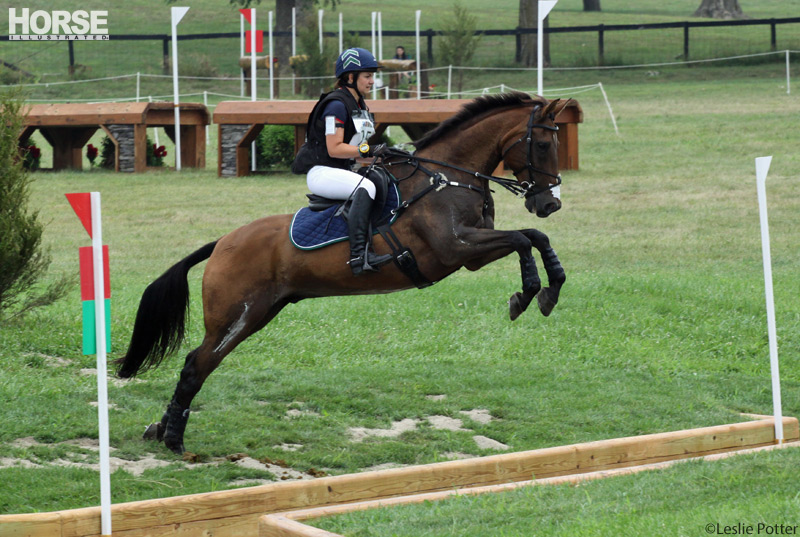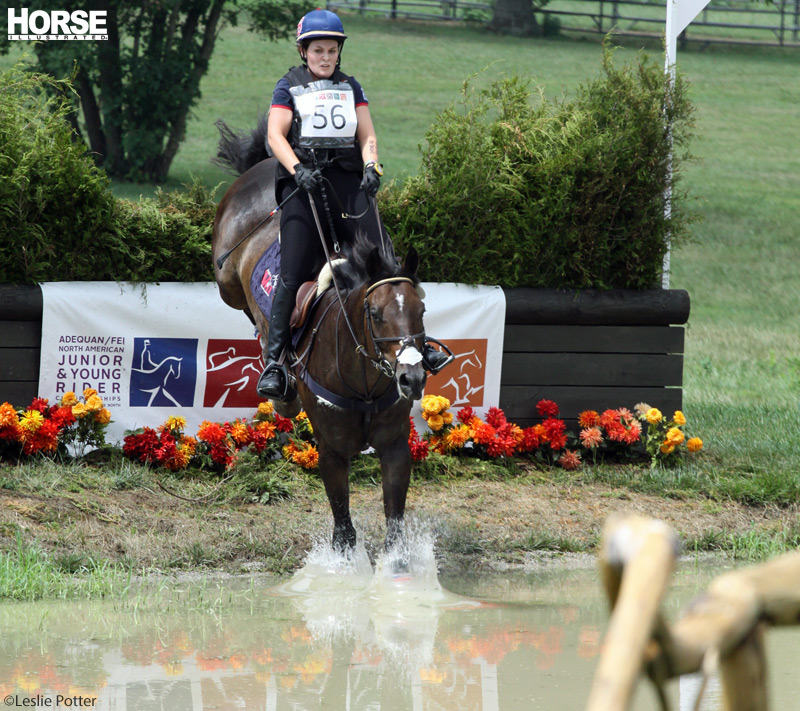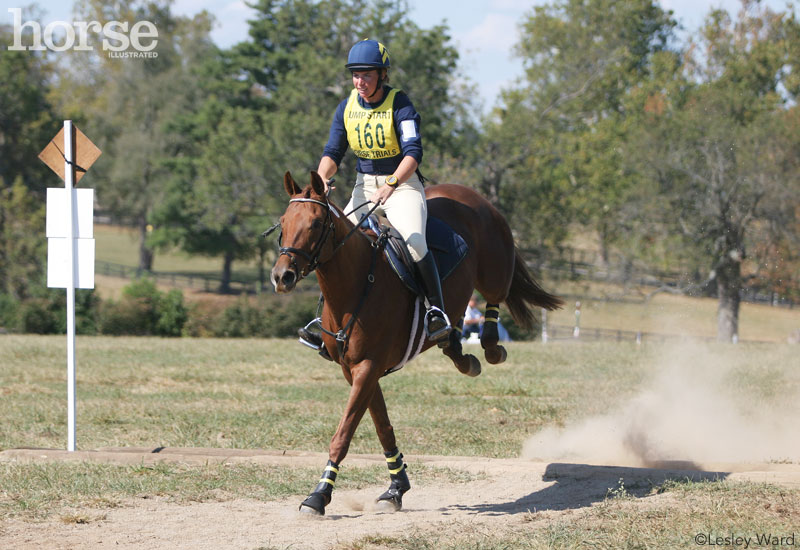Three basic types of cross-country obstacles—ditches, banks and water—must be carefully and systematically introduced to even the boldest cross-country horse. If you give your horse a good start over these jumps, there’s no reason to ever have a problem. But make the mistake of overfacing your green horse at them without proper training, and you’ll end up with a timid campaigner instead of an intrepid one.

Jennie knows all about developing event horses: She campaigned her own Thoroughbred gelding Jericho to the very top of the sport, finishing 9th at the Rolex Kentucky CCI*** in 1999 and completing the renowned four-star test there in 2000. The trainer and manager at Elenor and Larry Smith’s Tallwoods Farms in Canton, Conn., and Vass, N.C., Jennie teaches eventing students of all levels, many of whom are already qualified for the 2006 American Eventing Championships, to be held in September at the Carolina Horse Park in North Carolina.
“Ditches, banks and water each present their own unique and distinct challenge to the horse or rider who’s never faced these obstacles before,” Jennie explains.
Basics First
Jumping banks, ditches and water should never be considered by riders who have just started jumping or those mounted on green horses. “Before you even think of tackling these jumps, you and your horse should be comfortable hacking out alone through the countryside, working on hilly terrain and navigating simpler cross-country jumps—like logs, coops and stone walls,” Jennie says. “If you have control problems out in the open, you shouldn’t even think about cross-country jumping.”
Your horse should also move forward promptly off your leg. “Don’t attempt a jump your horse may question unless you’re sure he knows, from your flatwork training, that your leg means go, no questions asked,” Jennie explains. “That way he’ll listen to you instead of spooking away from something that scares him, like his first water crossing.”
In addition, if there’s ever a question of insecure footing on takeoff or landing, don’t present your horse to the obstacle. There is no surer way to scare a green horse than send him through a water obstacle in which the bottom gives way, or ask him to jump a ditch with an unstable landing. Make sure the physical conditions at the jumps you’re navigating ensure a good experience for your horse.
Water
When a green horse faces his first water crossing, he has no idea how deep that water is. For all he knows you’re asking him to step into a bottomless pool. Many horses also don’t understand what you want when you point them at water: Should they jump it or walk into it?
“It’s perfectly normal for almost any horse to question his first water obstacle,” Jennie says. “Never get mad or frustrated because your horse seems afraid of water.”
Select your first water crossing carefully. Avoid running water at first and steer clear of bad footing in or around the water. Choose a wide and shallow water crossing in a fairly level area that you can easily walk through, ideally in both directions. Rubber reins are also a good idea (as are gloves with a good grip) since splashing around in a water crossing will make your leather reins wet and slippery.
Factor in your approach, too. “If you choose a water crossing at the bottom of a steep hill, then you’ve added the difficulty of the downhill approach to the question,” Jennie explains. “The water itself is enough of a challenge for your horse to face. The approach shouldn’t be part of the problem.”
Always take a friend on an experienced horse the first few times you attempt water, ditches or banks. Start by walking both horses in the area around the water crossing several times, offering lots of pats and praise.
Then ask your friend to walk back and forth through the crossing a few times, while you stand to the side on your horse and just watch. Then get in line right behind your friend’s horse, and walk behind on a straight approach through the water. Your horse should walk right through and if he does, “praise him like he just won an Olympic medal,” Jennie says.
Then go around and walk again through the water from the same direction, if possible. “You won’t believe how much of a difference changing directions can make,” Jennie explains. “Let your horse get comfortable in one direction before you ask him to change.”
After several crossings in one direction, ask your friend to turn around and give you a lead going the other way. Walk through several times that way before you ultimately go back and forth together through the water. (If you can’t get around the water, you may have to go back and forth the first time—just follow your friend’s lead.)
If your horse seems very confident, ask your friend to wait on the other side while you walk through the water on your own toward him or her. Then turn around and try the same thing in the other direction.
“I would never ask a young horse to attempt water alone until he’s had several schools through water with a buddy first,” Jennie explains. “And if your horse has trouble getting into the water at first, don’t ask him to cross alone at all that first day. You can never be too cautious in these first introductory sessions.”

Starting your horse to water gradually in a low-pressure training environment in the beginning will make it possible to tackle more challenging water jumps later on in his career. Photo: Leslie Potter
Water Woes
What happens if your horse takes one look at that water and balks? “Don’t panic or punish your horse, but don’t let him turn away, either,” Jennie explains. “If you allow your horse to whirl and spin the other direction when he sees the water, you’re essentially telling him he’s absolutely correct to be afraid of what you’re asking him to do.” Don’t get mad at him for his fear, but don’t let him give to his natural inclination to turn and run from danger, either.
Encourage your horse to follow his buddy by using your voice and leg, but be willing to stand there as long as it takes. “Once he gets one foot wet, a horse will usually walk right through,” Jennie explains. “It’s that first step that can be tough.”
Give your horse all the time he needs, and as many leads as it takes to get him through the water that first time. Then ask him to go through again, and probably a third time, but that might be it for that day.
Once your horse comfortably crosses the water in both directions, get a lead from your friend and trot, and eventually canter, through the water (footing permitting). Jennie cautions, however, “it might take you several sessions before you try anything more than a walk.”
Advanced Work
At the Beginner Novice and Novice levels of event competition, competitors will only be asked to trot or canter through a water crossing. Only at the Training (3’3″) level will horses be required to jump into water. For this reason, Jennie wouldn’t recommend adding a jump to the water until your horse is comfortable without a doubt cantering through all types of water obstacles in various locations. When you are ready to add a jump, Jennie suggests using a cross-rail, a stride or two ahead of the water, then taking a lead from a friend through this simple exercise. Over time, move the cross-rail closer and closer to the water until eventually you jump the cross-rail and land in the water itself.
“When you’re ready to compete at the Training level, you’ll need to learn how to slip the reins and let your shoulders come back as you land over a jump into the water,” Jennie explains. “This is called the drop position, and it’s a fairly advanced technique you’ll need as your eventing career progresses.”
Banks
Banks present an unusual dilemma for your horse. “Before now you’ve always asked your horse to jump over something,” Jennie says. “Now you want him to jump up onto something, stay at that level for a stride or two, then jump off, into space, and back to ground level.”
Before working on a bank, make sure your horse is comfortable walking up and down a steep slope. Ideally, a beginning bank will have one sloping side so that you don’t have to try jumping both on and off the bank on your first try. That way you can practice jumping onto, then off, a bank before you try both elements at once.
Take a lead from your friend and follow that horse up and down the ramp side of the bank. Then pick up an organized, balanced trot, find a long straight approach to the up-bank, and then follow your friend’s horse right up the bank.
“While you want to walk your horse through his first water crossing or over his first ditch, trotting is best for bank practice, since the jump up requires some impulsion,” Jennie explains.
“In terms of finding a distance to the bank, think of it as a vertical jump and look right at the edge of the bank on your approach,” Jennie continues. “But grab your horse’s mane just before you jump because the feeling of jumping up a bank will feel new to you, and you may have trouble staying with your horse.”
Once your horse comfortably trots up the bank several times behind your friend’s horse, turn around and try the other way—trot up the ramp going onto the bank and jump off the bank. “Most green horses will overjump the first time they pop off a bank,” Jennie says. “So make sure you grab your horse’s mane and stay off his back as he lands.”
If your horse hesitates, don’t let him turn around—just stand and face him off the bank, and ask your friend to come around and give you another lead until your horse follows and jumps off.
Over much larger banks with steeper drops, riders will eventually need to learn the drop position. “But for now I recommend that riders learn to stay with their horses off a bank by grabbing mane right through to the landing,” Jennie explains. “Try to really sink into your heel and let your lower leg absorb the shock of the drop.”
Make sure you look up and out as you drop off a bank, as looking down will encourage you to fall forward ahead of your horse. And never worry about how many strides you get on top of the bank. “It’s your horse’s job to navigate the bank in a way that makes him feel most secure,” Jennie explains. “Many horses will shuffle in several extra strides before they jump off a bank. Don’t worry about this—they’re just being careful about where they place their feet. Other horses will leave a stride out and leap off the bank at first, but they’ll usually give this up after they’ve trotted the bank a few times.”
Stick to trotting the bank, slowly and calmly in both directions, for several sessions before you try cantering the bank. “Never, ever use speed when jumping a bank,” Jennie cautions. “Always approach a bank in control and balance. That’s why we trot banks at first, so the horse understands this is an obstacle where he needs to be careful and athletic. Your horse should never feel he has to use speed to power his way on or off a bank.”
Ditches
That first ditch will always surprise a horse. “You’re facing your horse at a hole in the ground and asking him to jump it,” Jennie says. “He’s got to be thinking, ‘are you nuts wanting me to jump this, or what?’ ”
Choose a shallow, clearly defined ditch with a level approach. “Start with a ditch that you can easily walk over yourself,” Jennie explains. “If you can step over the ditch, so can your horse.”
Follow your friend’s lead and circle the ditch at a walk, in both directions, several times. Unlike other types of obstacles, don’t show your horse the ditch first. “He’s bound to spook away from it, which will only make him more scared,” Jennie says.

When you’re ready, ride an active, energetic walk behind your friend on a straight line right over the ditch. (If you prefer to trot the ditch, or trot the last few steps, that’s fine, too.) “So many riders make the mistake of galloping their horses over their first ditch,” Jennie explains. “Then the horse never has a chance to understand the question. You want your horse to go slowly enough that he has time to see the ditch and realize it is a hole in the ground that he needs to get over.”
Your horse will probably overjump his first few ditches. “Be sure you grab the mane so you can stay with your horse’s leap,” Jennie cautions. “It’s more difficult to stay with a horse when you jump from a walk.”
When your horse jumps the ditch, praise him, then follow your friend over again. Change directions only when your horse is perfectly comfortable navigating the ditch in one direction first.
If your horse says no, remain patient and follow the same procedure you used at the water. Ask your friend to come around again and walk over the ditch right beside you while you urge your horse forward with voice and leg.
“Remember, if you can step over this ditch, so can your horse,” Jennie explains. Stand there as long as it takes until your horse gives it a try.
Once your horse happily steps over the ditch in both directions behind his buddy, you can trot and eventually canter the ditch. You can gradually progress to slightly wider and deeper ditches, but always take a lead through several schools until your horse’s confidence seems secure.
Keep it Simple, Keep it Slow
If there’s a common element in teaching your horse to jump banks, ditches and water, it’s this: Don’t be in a hurry.
“Give your horse all the time he needs to figure out these strange new obstacles,” Jennie explains. “Allow your horse the opportunity to truly understand these cross-country challenges, and he’ll have no need to question them in the future. Then build progressively to more difficult situations, like adding cross-rails in and around the water or before and after the bank or ditch.”
It’s these first few training sessions, Jennie maintains, that make all the difference in your horse’s eventual cross-country attitude. “Do your homework now,” she says, “and one day your horse will look at a ditch and think, ‘Hey, that old hole in the ground? It’s no big deal to me.’ “
Further Reading
Entry-Level Eventing
Make Your Own Cross-Country Jumps
Annie Eldridge is an event rider who trains out of her Setters’ Run Farm in Duxbury, Mass.






Cross-country is fun, but remember to keep you and your horse safe. Take all safety precautions. It’s not fun when someone’s hurt.
This was really cool! I will use it if I ever ride a horse that is scared of those three jumps!
This article helped me tons! I never could find a book that explained how to do the maneuvers like this article does. Thank you!
Those articles sound like alot of fun, even if you don’t compete in cross country! Thanks for the information.
good info
Excellent article! I plan on training my mare for eventing evntually and this helped in getting my foot in the door.
This what i would like to teach my long legged filly….someday.
Hope I can remember all of this.
great article!
Hopefully Ill get out this summer with my green mare!
Love the video on Banks and the picture of the water jump!!
Both had a great chemistry while riding.